Our two-week Sardinia itinerary takes you on a road trip to the very best beaches, mountain scenery, sparkling coastline and historic sites that make this diverse and beautiful island so unique.
We’ve spent a lot of time in Italy over the years and it’s unquestionably one of our very favourite countries to visit. And just when we thought we had seen everything this beautiful country had to offer, we embarked on a Sardina road trip.
Here you’ll find an island of wild beauty, rugged mountain ranges, lush valleys, ancient forests, and a coastline to die for, with an abundance of white sand beaches and oh-so inviting, crystal clear turquoise bays.
There really is something here for everyone.
Beachgoers will find themselves completely spoilt for choice with postcard-perfect bays and islands aplenty. Nature lovers will find stunning hiking trails and adventure sports on offer. History buffs could keep themselves busy for a lifetime exploring thousands of bronze age Nuragic sites and Roman ruins. Culture vultures will love the quaint traditional villages, colourful cobblestone medieval towns, and beautiful Italian architecture. While foodies will be in culinary heaven with traditional, locally-sourced cuisine like malloreddus pasta, fresh seafood, Sardinian pecorino, and of course the island’s most famous tipple, Cannonau wine.
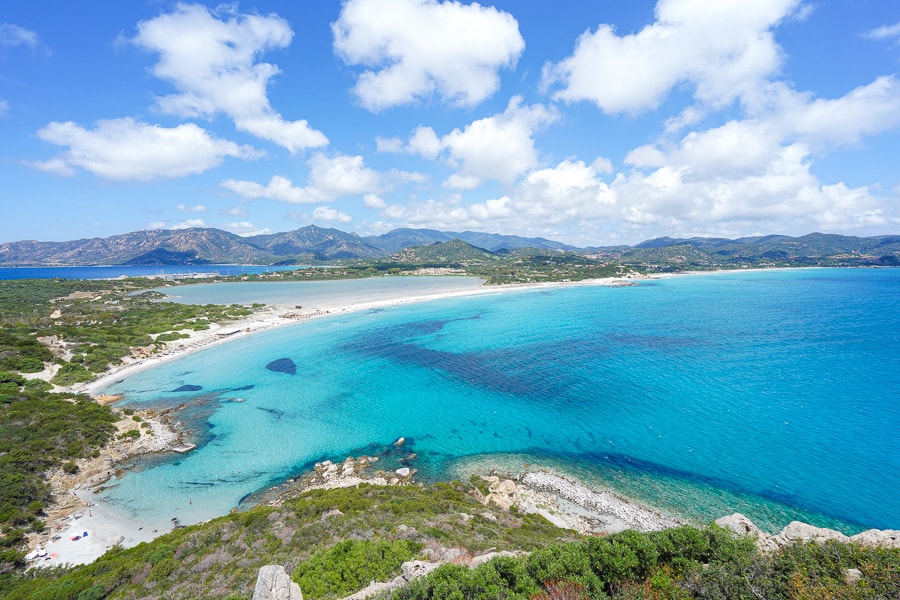
Two Week Sardinia Itinerary Snapshot
Start: Cagliari, Italy
Finish: Cagliari, Italy
Distance: 1,500km (930 miles)
How long do I need? You’ll need a minimum of two weeks to complete a loop of Sardinia from Cagliari in the south. This fantastic road trip travels clockwise to take in some of the island’s best Nuragic sites, the incredible La Maddalena archipelago in the north, the mountains of the Supramonte, and the Gulf of Orosei’s mesmerising coastline in the east.
Overnight stops: 4 nights in Cagliari, 3 nights in Alghero, 3 nights in Palau, 4 nights in Cala Gonone.
What’s in this post?
Planning a Sardinia Road Trip to
Two Week Sardinia Itinerary
Day 1 – Cagliari Sightseeing
Day 2 – Nora & Bay of Chia: Beaches & History
Day 3 – Capo Carbonara: Beaches & Views
Day 4 – Cagliari to Alghero via Bosa and Nuragic Sites
Day 5 – Alghero’s Historic Sites plus Wine
Day 6 – Cappo Caccia Coastline Discovery
Day 7 – Scenic Drive from Alghero to Palau
Day 8 – La Maddalena Archipelago Boat Tour
Day 9 – Costa Smeralda Beaches
Day 10 – Palau to Cala Gonone via Olbia
Day 11 – Cala Gonone Hiking
Day 12 – Gulf of Orosei Boat & Beaches Tour
Day 13 – Around Cala Gonone
Day 14 – Cala Gonone to Cagliari via the Supramonte
Homeward Bound
This post contains affiliate links. If you choose to purchase through these links we may receive a small commission, at no extra cost to you, which helps us to keep this website running. Your support is very much appreciated!
Planning a Sardinia Road Trip
What’s the Route?
You can start this two-week Sardinia road trip from any of the major towns or port cities on the route, however we’ve commenced the trip from the island’s capital, Cagliari, as it’s the most common point of arrival by plane.
Be Prepared to be Busy
2 weeks in Sardinia is just about enough time to see the whole island and the main highlights, but it’s a very busy two weeks that packs a lot in.
If you want a more relaxed Sardinia visit with more beach time, you may need to consider adjusting the itinerary.
For example, you could easily spend a lazy couple of weeks in the north of Sardinia based in Cala Gonone and Palau. While this would allow plenty of beach and island time, and a taste of the Sardinia’s Nuragic sites, there would, of course be trade-offs.
If you’re like us though, and want to see all the main highlights of Sardinia, stick to the ‘action packed’ option. Or, if you have the luxury of time, stay longer.
Travelling clockwise, our Sardinia itinerary uses four main bases to explore the island, Cagliari in the South, Alghero in the west, Palau in the north, and Cala Gonone on the east coast. This allows you to explore each region from a convenient point without having to change accommodation all the time.
This route takes us to the incredible Roman site of Nora, the mysterious and evocative Bronze Age Nuragic complexes of Santa Cristina, Su Nuraxi di Barumini, and Palmavera. We travel through, in and around the dramatic mountainous region of the Supramonte massif, past the colourful towns of Bosa and Castelsardo, and some of the best coastline, islands and beaches in Europe.
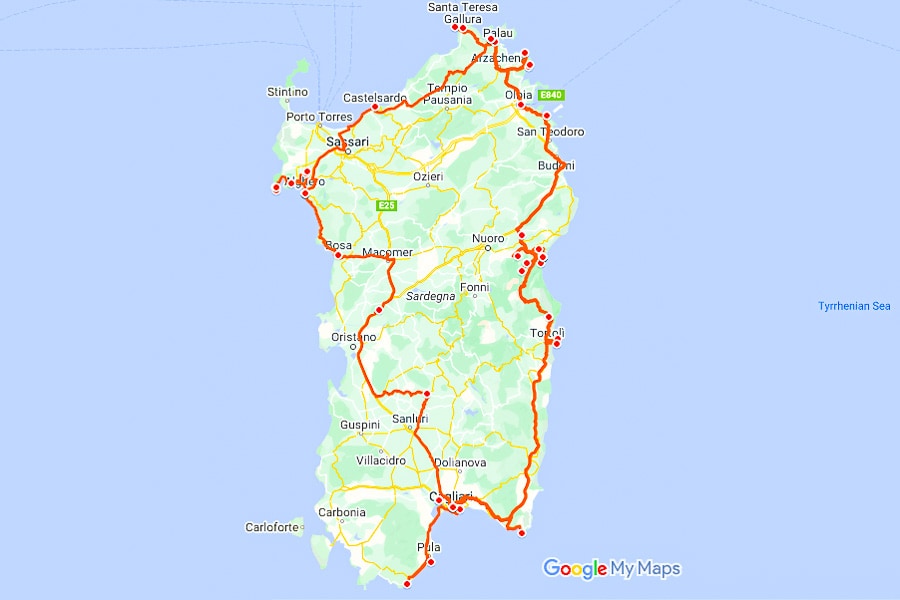
If you have the luxury of more time, and can extend your Sardinia road trip to three or even four weeks, you could:
- Enjoy a few more rest, or beach days.
- Explore the dunes and unspoilt beaches of spectacular Costa Verde in south west Sardinia.
- Spend a night or two in peaceful Oristano, and visit the Roman City of Tharros nearby on the Sinis Peninsula.
- Check out the colourful stair mural leading to the church of Saint Lucia in Arzachena, along with the huge La Roccia del Fungo nearby.
- Delve deeper into Sardinia’s Nuragic past with visits to Nuraghe Albucciu, Tempietto Malchittu, Tombe dei Giganti Coddu Vecchiu, and Nuraghe Santu Antine.
- Experience more of Sardinia’s fantastic hikes, including those to Cala Golritze, Tiscali, and Cala Luna.
Best time to Visit Sardinia
Sardinia enjoys a Mediterranean climate, with fairly hot, dry summers and mild, wetter winters. However, the weather can vary across the island due to its diverse geography.
Personally, we feel the best time to visit Sardinia is springtime (between March and May) and autumn (between September and November). While still warm during these months, temperatures are less harsh than in the summer months. It’s also still warm enough for a swim (although a bit fresh, if we’re honest), and you can hike without feeling like you’ll expire at any moment. The only downside of course, is there’s a little more rain.
Summers in Sardinia (June to August) are typically warm and dry. While this is perfect beach weather for many, it’s a little too hot for our taste (and pasty skin). The winter months between December and February are relatively mild, with daytime temperatures averaging between 10 and 15 degrees celsius, and more frequent rainfall.
We visited in May and June and had mostly dry, warm weather with plenty of hot sunny days. We did have the occasional storm however, and a few rainy days.
Driving in Sardinia
We arrived in Sardinia after two months driving on the mainland, so to be honest we were expecting more of the same crazy, hair-raising Italian driving experiences.
Thankfully, for the most part that wasn’t the case, and we were pleasantly surprised by decent, well-maintained roads and highways, fewer ZTL limited traffic zones, no expensive road tolls (yay), and for the most part, much less busy and crazy driving.
That’s not to say driving in cities like Cagliari is a breeze. You’ll need your wits about you for sure, but it’s not on the same scale as the mainland.
Other than that, the usual rules apply with regard to driving in Sardinia:
- Book car rental in advance to avoid disappointment and get better rates;
- Unless you’ll have mobile roaming, download offline Google maps;
- Avoid driving into old towns or historic zones with their cobbled streets and tight lanes, especially if you see a Zona Traffico Limitato (red circle with white centre) sign;
- Watch out for local parking restrictions (Google Translate is your friend here); and
- Never leave valuables in your car.
You’ll need a car for this itinerary, so unless you plan to bring your own across, you will need to hire one. We suggest checking prices on both Rental Cars and Discover Cars to find the best deal you can.
Where to Stay in Sardinia
As a popular tourist destination, Sardinia has a variety of accommodation options ranging from stylish beach resorts, to mid-range and budget hotels, bed and breakfasts, apartments and backpacker hostels.
We’ve chosen decent-sized towns and cities as our bases for this Sardinia itinerary, and as such, all have a good range of accommodation to suit all budgets.
Plan ahead if you are visiting Sardinia during peak season as, like all popular destinations, accommodation can fill up well in advance.
You can book accommodation through all major booking engines, and direct in some cases. We generally use Booking.com when looking for places to stay.
When we road trip, and as we did when we were touring Sardinia by car, we tend to look for accommodation in each place with free parking that’s within walking distance of the main attractions.
While sometimes this means you don’t get to stay right in the city or town centre, it does have the added benefit of helping to burn off all those delicious food and wine calories, and allowing you to explore more of the local, less touristy areas.
Taking a Ferry to Sardinia
Depending on where you are coming from, or if you want to bring your own car, travelling to Sardinia by ferry might be a good option for you.
There are a number of ferry routes that operate between mainland Italian, French and Spanish ports, as well as from nearby Corsica, and Sicily. These ferries operate to and from Sardinia’s major port cities of Olbia, Porto Torres, Cagliari, Golfo Aranci and Arbatax.
Many of the longer trips operate overnight, however in summer there are definitely more options, including daytime sailings.
We travelled by ferry to Sardinia with our own car from Civitavecchia near Rome on an overnight sailing that took 8 hours. As we’d read mixed reports of the crossing, we paid extra for a simple cabin with ensuite bathroom. On the return trip we took the daytime ferry to Toulon. It’s a long day, so if you take this option make sure you have plenty of music, a good book, and lots of snacks.
Two Week Sardinia Road Trip Itinerary
Day 1 – Cagliari Sightseeing
Highlights: Poetto Beach | Il Castillo | Bastione di Saint Remy | Torre di San Pancrazio | Torre dell’Elefante | Cattedrale di Santa Maria | Museo Archeologico Nazionale | Anfiteatro Romano | Santa Restituta Crypt
Total driving distance: appx. 27km (17 miles)
Total driving time: appx. 35 minutes
Overnight: Cagliari
We always like to keep day one of any itinerary flexible to accommodate arrival times and travel logistics, like picking up a hire car and generally getting settled. As such, Day One of our itinerary is focused in and around Cagliari in the south of Sardinia, the island’s ancient bustling capital.
After picking up your hire car, we recommend starting the day by heading to the famous sands of Poetto Beach . Grab a coffee and snack at one of the many kiosks, take a stroll along the sand, and pop across the road to Molentargius Nature Reserve. If you’re lucky you may spot some of the resident flamingos or other birdlife that call this urban salt basin home.
There’s a lot to see in Cagliari, but fortunately most sites of interest are located in and around the city’s imposing hilltop citadel, Il Castello. These sites can be covered in a day on a self-guided wander, over multiple days as you can fit them in, or by joining one of the many available walking tours.
Suggested Cagliari self-guided walking tour
We started every visit to Cagliari’s historic centre by walking up the curving monumental staircase of Bastione di Saint Remy to enjoy the breeze and incredible city and sea views from the upper terrace.
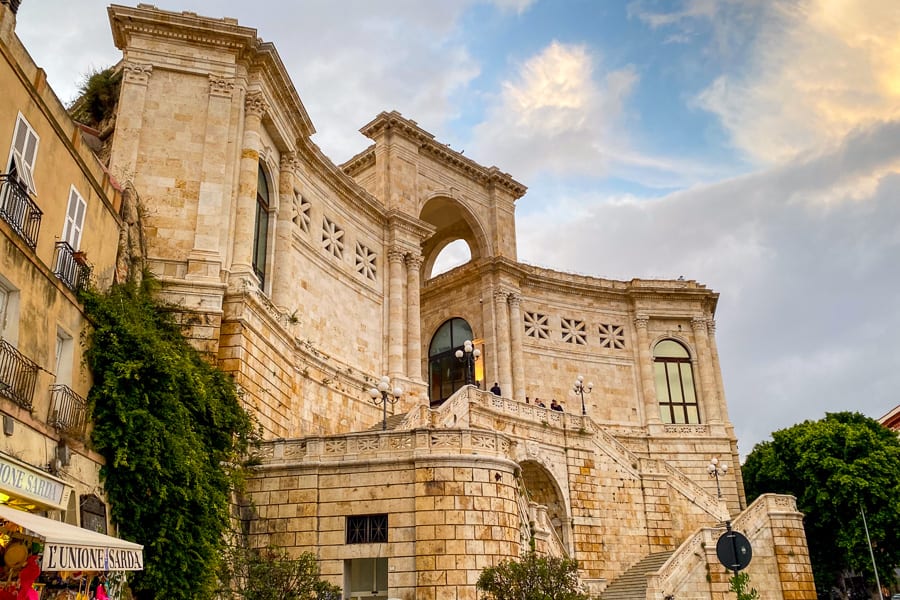
Start at the Museo Archeologico Nazionale with its world famous bronzetti figurines and the mysterious, three thousand year old Giganti di Monte Prama statues.
From here, it’s a short walk downhill to the mostly ruined, but still incredibly evocative 2nd century Anfiteatro Romano, before strolling past the university, and down beside the slightly dishevelled, first century Villa di Tigellio.
Next you’ll skirt the city’s nightlife district to visit a cluster of notable churches in the Stampace neighbourhood: San Michele, Saint’ Anna, Saint Ephysius and the Santa Restituta Crypt.
Grab some well-deserved refreshments before climbing back up to explore the atmospheric streets, laneways and piazzas of Il Castello, including the 13th century Cathedral and the Torre dell’Elefante. Be sure to take the opportunity to climb to the top for some of the best views in Cagliairi.
We finished our first day with a well-deserved sundowner at Caffè Libarium Nostrum. It’s set on a terrace overlooking the port and provides complimentary appetisers with your drink.
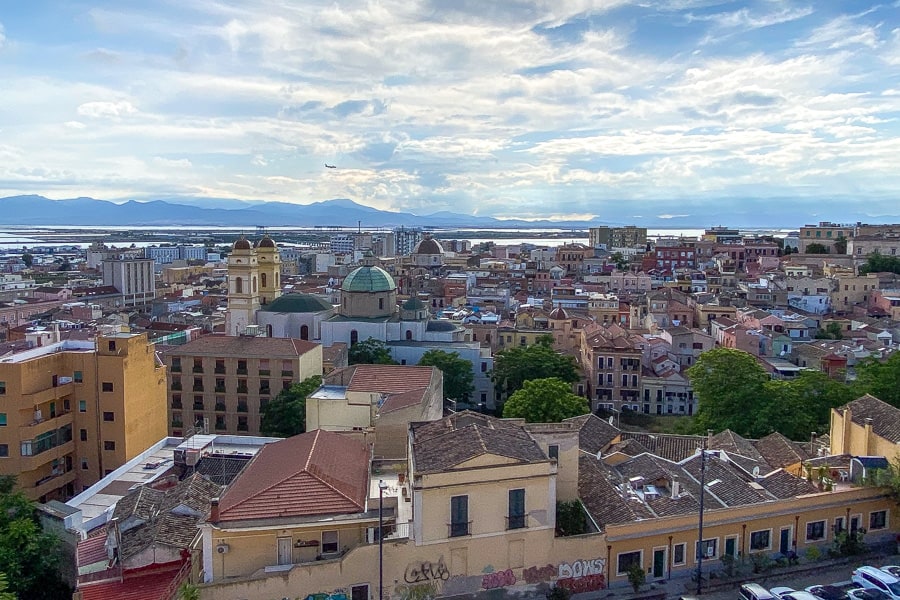
Where to Stay in Cagliari
As the island’s principal city, there’s a variety of accommodation in Cagliari ranging from budget rooms and hostels to high-end hotels.
We booked a room at peaceful and comfy Anania, located in a quiet suburb in the north-east of the city and just 15-20 minutes’ walk from Il Castello. Being further out meant we were able to find free, on-street parking for our car, and also easily access the main roads in and out of the city for excursions.
The following options also get consistently good reviews:
- Good value: Casa Diaz – comfortable | 15 min walk to centre | opposite large free public carpark
- Mid-range: Palazzo Dessy – great central location | spacious comfy rooms | parking nearby at cruise terminal
- Indulge: Palazzo Doglio – large modern rooms| vibrant central location | parking garage (paid)
Day 2 – Nora & Bay of Chia: Beaches & History
Highlights: Nora Archaeological Site | Strada Panoramica | Bay of Chia | Sa Colonia Beach
Total driving distance: appx. 114km (70 miles)
Total driving time: appx. 2 hours
Overnight: Cagliari
Today’s itinerary combines Sardinia’s ancient past while highlighting its natural beauty, with a 40-minute drive to the southernmost tip of the island to visit the ruins of ancient Nora and the nearby Bay of Chia.
Nora Archaeological Site
Founded by the Phoenicians in around 8 BC, Nora’s history spans the Carthaginian, Roman and Byzantine periods, making for a fascinating journey through time.
On arrival, we downloaded the official app, NorApp, to guide our wander through the mainly Roman remains of this beautiful site, nestled on a narrow headland overlooking the sparkling Tyrrhenian Sea.
While some of the site requires a little imagination, you can easily spend a couple of hours here, meandering through ancient streets past the foundations of Roman homes, well preserved mosaic floors, thermal baths, ruined temples and marketplaces.
Be sure to seek out the impressive Roman Theatre, crumbling ‘Terme a Mare’ thermal baths, and the nearby Atrio Trestastilo (House of Tetrastyle Atrium) with its distinctive pillared atrium and mosaic floors. They’ll give you a real feel for what the city might have been during its Roman heyday.
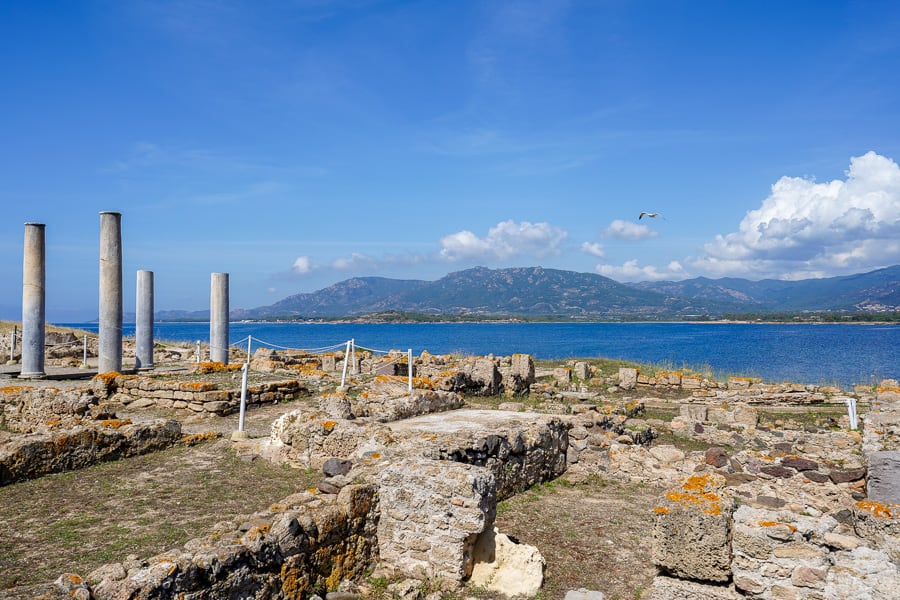
Explore the Bay of Chia Beaches
Head south from Nora until you get to the SP71, aptly named the “Strada Panoramica”, and either enjoy the views of this incredibly scenic road all the way to Porto di Teulada, or do as we did, and turn off at a beach of your choosing.
There are dozens of beautiful sandy beaches along the SP71, the best of which include Su Giudeu, Domus de Maria, Cala del Morto, Sa Colonia, Teulada, Monte Cogoni and Cala Cipolla.
We opted for Sa Colonia at the northern end of the Bay of Chia, as it had decent parking and a nice kiosk right on the sand for lunch. We spent a lovely couple of hours here with the ambient Torre di Chia watching over us as we enjoyed a swim and sunbathe before heading back to Cagliari.
Spend the afternoon catching up on any of the sites in Cagliari you missed yesterday, and finish with a beer at Dry Hop on Scalette di Santa Chiara, before finding dinner along buzzing eat street, Corso Vittorio Emanuele II.
Day 3 – Capo Carbonara: Beaches and Views
Highlights: Hike up Torre di Porto Giunco | Flamingos at Stagno Notteri | Spiaggia di Porto Giunco
Total driving distance: appx. 104km (65 miles)
Total driving time: appx. 2 hours
Overnight: Cagliari
Just an hour east of Cagliari is Capo Carbonara, one of the most beautiful places to see in Sardinia. Jutting out on a rocky headland south of the town of Villasimius, you’ll find the picture-perfect white sand beach of Spiaggia di Porto Giunco. Its impossibly turquoise coastline is overlooked by a tower of the same name.
To get here, follow Via Degli Oleandri from Villasimius until you get to the sandy turnoff for Via dei Ginepri, which you will follow around the lagoon until it finishes at Parcheggio Porto Giunco.
Start your visit with a sweaty, but not overly-challenging, 20-minute hike up to Torre di Porto Giunco. You get a sense of the views as you go up, but the breathtaking 360-degree panorama from the tower itself was definitely one of the highlights of our Sardinia trip.
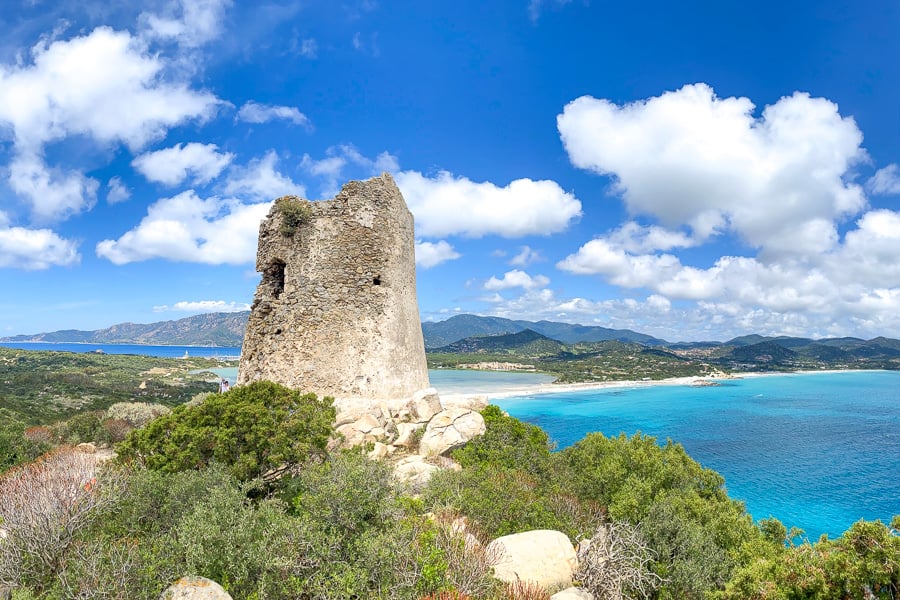
Enjoy the scenery for a while and keep your eyes peeled for passing falcons, before heading down to the beach for a walk around nearby Stagno Notteri. We actually saw more flamingos here than we did at Poetta Beach.
You could easily while away the day here enjoying the calm ocean and beautiful sandy beach. There’s a public toilet at the tower end of the beach, and a handful of beach clubs to grab lunch or a drink.
Day 4 – Cagliari to Alghero via Bosa and Nuragic Sites
Highlights: Su Nuraxi di Barumini | Nuraghe di Santa Cristina | Bosa
Total driving distance: appx. 250km (155 miles)
Total driving time: appx. 3 hours 45 mins
Overnight: Alghero
Day 4 of our two-week Sardinia road trip is a big one, so we recommend getting started early and loading up on coffee before departing Cagliari.
Our drive today takes in perhaps two of the most important Nuragic sites in Sardinia, the World Heritage site of Su Nuraxi di Barumini, and the unique well temple at Nuraghe di Santa Cristina.
What is a Nuraghe?
Nuraghi (the plural of nuraghe) are distinctive Bronze Age stone corbel-vaulted towers found throughout Sardinia, often in elevated locations.
While their function is still contested by archaeologists and historians, the most common explanation we were given is that they were built for defensive purposes by local families and clans.
There are more than 7,000 Nuragic sites in Sardinia, ranging from single towers to extensive Nuragic complexes. Many are thought to have been extended over time to meet additional social and defensive needs.
Su Nuraxi di Barumini
Plan to be at Su Nuraxi di Barumini for opening at 9am so you can get on the first guided tour of the day in your language. The informative tours take around an hour and provide a great opportunity to explore the sprawling Nuragic complex and climb the 1500BC tower at the centre of the site.
The views from the top of the tower give you a bird’s eye perspective of how the interlocking circular beehive structures within the complex are arranged, while exploring the conical towers provides a window into the distant past.
Nuraghe di Santa Cristina
An hour or so north of Su Nuraxi di Barumini, the E25 takes you past one of Sardinia’s most photographed Nuragic sites, Nuraghe di Santa Cristina.
This incredibly ambient site encompasses an early Christian settlement, as well as the 1,100BC Nuragic complex, featuring a central 6-metre high nuraghe and a couple of unusual elongated Nuragic huts.
The main drawcard here though is the remains of the Tempio a Pozzo, a stunning, keyhole-shaped well temple with finely cut basalt stairs that descend ominously into the ground. Beautiful and evocative at any time, the temple is said to be particularly impressive during the March and September equinoxes.
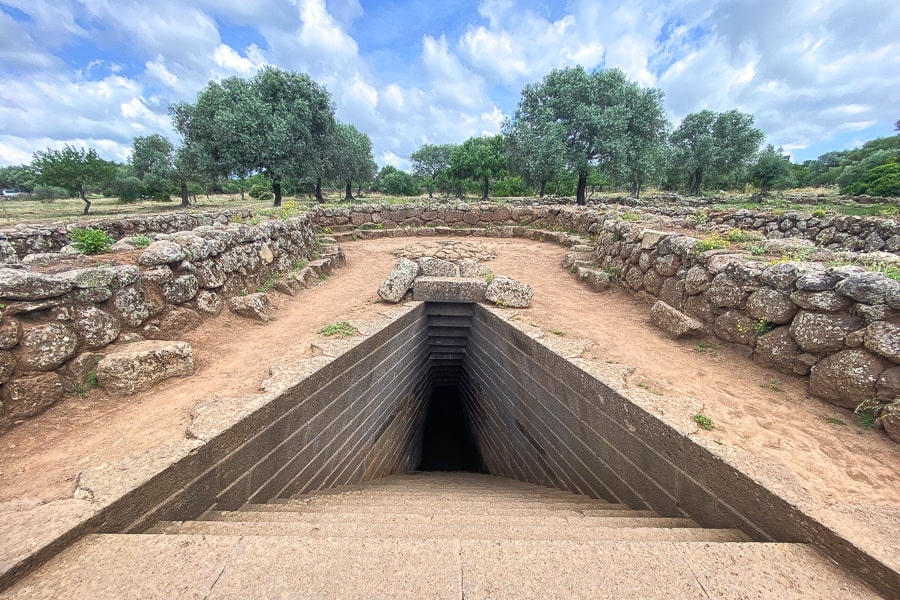
Explore Bosa
Around 45 minutes north-west of Nuraghe di Santa Cristina lies one of the most picturesque towns in Sardinia. Multicoloured houses cling to the hillside, while an imposing 19th century castle looks out over the town of Bosa and the Temo River.
We parked south of the river at a parking lot along Via Delle Conce before grabbing a late lunch while appreciating the fabulous views of this colourful little town.
After lunch, walk across Ponte Vecchio into the oldest part of town. Pick up a gelato and spend a couple of hours wandering the cobbled streets and colourful laneways of Bosa, ending your visit with sweeping views and a tangible sense of history atop the hill at the iconic Castle Malaspina.
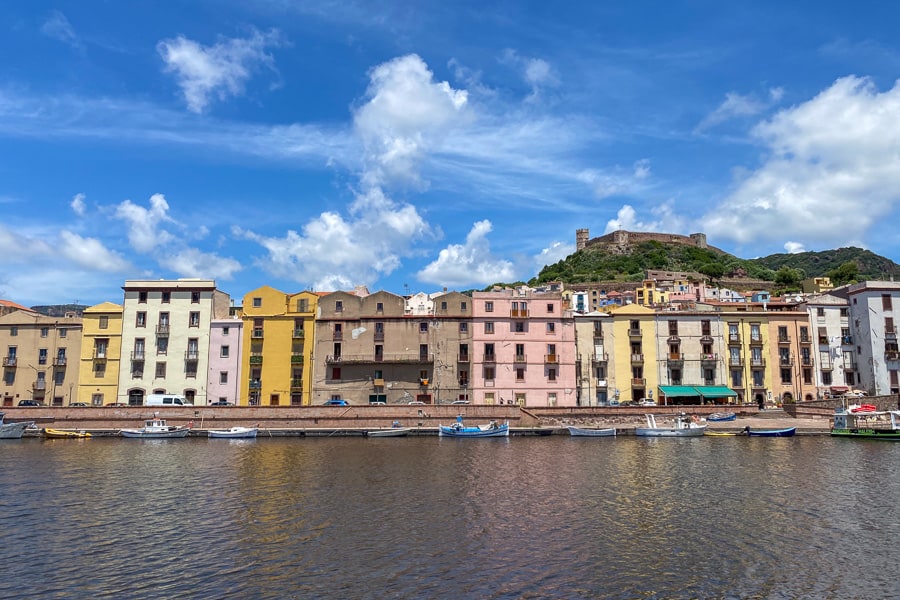
Today’s epic drive ends with a final hour-long stretch to Alghero. By this point you’d be excused for being completely exhausted. However, if you have the energy, we’d highly recommend dropping off your bags and taking a walk into Alghero along the seaside Lungomare as the sun drops.
Want to see more Nuragic sites?
If Nuragic sites are more your thing, then an alternative route for the afternoon would be to skip Bosa, and drive from Nuraghe di Santa Cristina to Alghero via Nuraghe Santu Antine.
This adds an extra 85km (53 miles) and around half an hour extra driving to your day.
Over three millennia old, history lovers will especially appreciate the 17-metre high central tower and well-preserved interconnected archways that link the two smaller chambers at this evocative Nuragic site.
Alghero Accommodation
While we would have loved to stay in Alghero’s beautiful medieval Centro Storico, it was easier to find a place with parking a little further out. In the end, we opted for Appartamento Mosas, a spacious, comfortable, fully-equipped two bedroom apartment, located an easy 15-minute stroll from the centre.
Not only did this allow us to organise our own food for breakfast and some lunches, but it also meant our daily walk into Alghero was along the Lungomare, with views of the historic centre and imposing sea walls for company.
There’s a fabulous range of accommodation options in and around Alghero, with the following getting consistently good reviews:
- Good value: White Charme Accommodation – 20 min walk to old town | helpful host | clean rooms | on-street parking
- Mid-range: Relais Apartments Mercede – modern 1br apartment | very close to old town | on-street parking (can sometimes be tricky)
- Indulge: Hotel Catalunya – 5 min walk to centre | port and old town views | comfy modern rooms | paid parking 5 mins away
Day 5 – Alghero’s Historic Sites plus Wine
Highlights: Nuraghe Palmavera | Anghelu Ruju | Sella e Mosca | Alghero Bastioni (sea walls)
Total driving distance: appx. 41km (25 miles)
Total driving time: appx. 1 hour
Overnight: Alghero
While the main focus of visiting Alghero is the charming medieval city, there are a few sites nearby that are absolutely worth a half-day excursion.
Nuraghe Palmavera
Start today with a trip to Nuraghe Palmavera, just 20-minutes’ drive around the bay from Alghero. This relatively compact, but very well-maintained site is focused on a large central tower surrounded by a courtyard and several huts, showcasing the intricate design and layout of this 1,500BC Nuragic settlement.
Necropoli di Anghelu Ruju
Heading out past the airport, it’s just over 10-minutes’ drive past farmland and vines to reach the Necropoli di Anghelu Ruju. Dating back over 5,000 years, it’s another site you’ll need to bring some imagination to in order to really appreciate what you’re seeing.
In all there are 38 tombs, known as domus de janas (fairy houses), carved into the landscape here. While most have been stripped bare or collapsed over time, some still retain faint ritual carvings in the stone, such as the famous bull horns in tomb A.
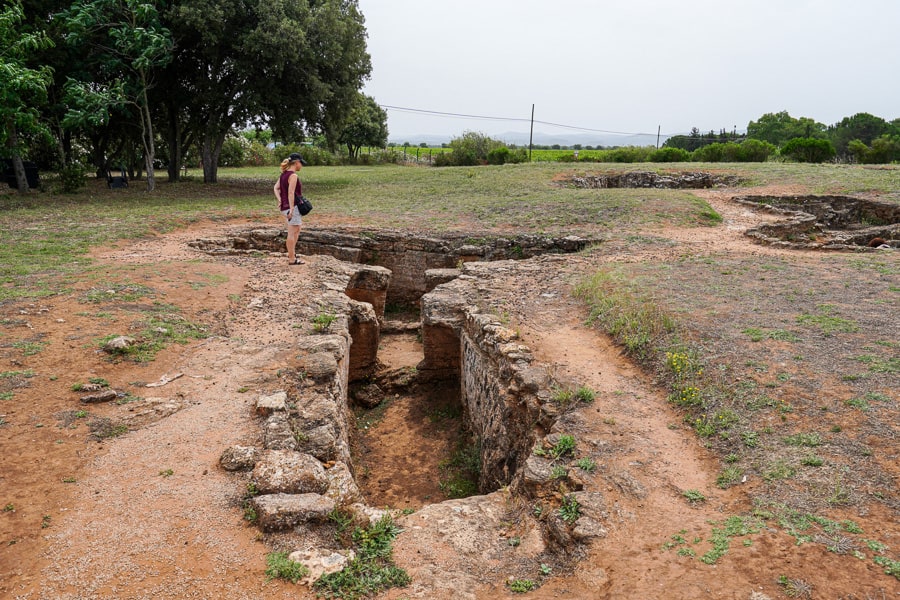
Nuraghe Palmavera and Anghelu Ruju can be visited individually for €5 each, or on a combined €8 ticket. Audio guides are also available at both sites.
Sella e Mosca Winery
As luck would have it, Sardinia’s top wine producer, Sella e Mosca, is conveniently located a couple of minutes from Anghelu Ruju, so it would be rude not to pop in for a visit while in the area.
As this was a spur of the moment stop for us, we hadn’t booked ahead. So we just headed to the small tasting room in the uber modern enoteca to try a couple of informal tastings. The Cannonau didn’t disappoint, and we had a few bottles clinking away in the boot on departure.
If you’re interested in seeing a bit more of the winery, there are a variety of tours available. See the Sella e Mosca website for more details, including timing, inclusions and costs.
Walk Alghero’s Impressive Bastioni (sea wall) and Cetnro Storico
In the afternoon, take a stroll down the Lungomare into Alghero’s historic centre. There are plenty of spots along the way for a late lunch or drink. Which is why that slow meander into town was one of our favourite things to do in Sardinia.
From the south end of the city, the Bastioni begins with the hulking Torre dell’Espero Real near Piazza Sullis. From here, take a leisurely stroll along the wall’s pedestrian pathway, winding your way past the many restaurants and bars set up for that perfect sunset-over-the-ocean aperitivo.
At the north end of the wall, pass through Porta a Mare and down towards the marina, a nice spot for some late afternoon sun and a cheeky gelato.
We finished our day with negroni sundowners on the Bastioni at The Kings restaurant, followed by some tapas at lovely SardOa in the centro storico with views of Cattedrale di Santa Maria.
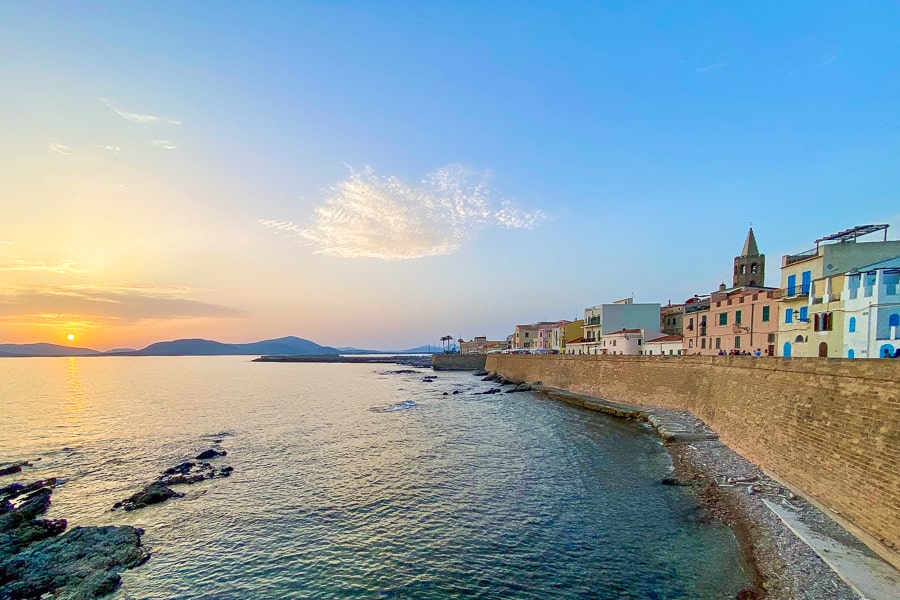
Day 6 – Cappo Caccia Coastline Discovery
Highlights: Grotta di Nettuno | Cappo Caccia | Grotta delle Brocche Rotte Hike | Alghero Centro Storico | Cattedrale di Santa Maria
Total driving distance: appx. 50km (31 miles)
Total driving time: appx. 1 hour
Overnight: Alghero
Whether you’re into exploring caves, hiking coastal trails, or simply absorbing rugged natural beauty, a visit to Capo Caccia is an absolute must when exploring the north of Sardinia.
We made the 26km trip from Alghero mid-morning with the intention of parking up and tackling the gruelling, but apparently spectacular, 654 step, near-vertical trail down to Grotta di Nettuno.
Unfortunately we had to abandon our plans due to there being nowhere to park anywhere remotely near the stairway. Learn from our mistake – if you want to get to see these stunning sea caves with their magical stalactites and stalagmites, you’ll need to arrive very early, or take one of the tourist boats from town.
Fortunately, there’s a lot more to Capo Caccia than the famous cave, with beaches, hiking and biking trails dotted around the rugged limestone headland of Porto Conte Nature Park. In fact, less than 5-minutes’ drive from Grotta di Nettuno’s small car park, you’ll find a little turnoff to your left that takes you up to today’s highlight – the short, but spectacular hike to Grotta delle Brocche Rotte.
You get a lot of bang for your buck with this short (1.2km return), but well-marked hike. It’s a slightly rocky climb up, but within a few minutes the incredible views across the peninsula and back towards the bay of Porto Conte will take your mind off the exertion. There’s a little bit of scrambling to get to Grotta delle Brocche cave, but the views are wonderful, and the shade, once you get there, is very welcome.
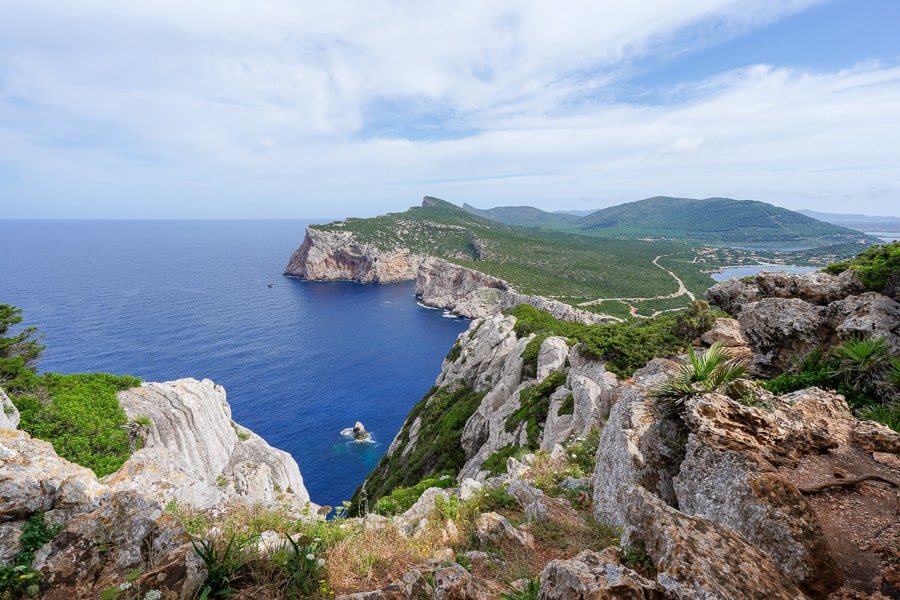
Grab a snack, and perhaps a swim at tiny Cala Dragunara before heading back to Alghero.
You can choose your own adventure this afternoon, but if you’re anything like us, you may well find yourself wandering the cobbled streets and laneways of Alghero’s beautiful Centro Storico and enjoying the views from the Bastioni. Or, if you are feeling energetic, from atop the Campanile bell tower at Cattedrale di Santa Maria.
Day 7 – Scenic Drive from Alghero to Palau
Highlights: Castelsardo | La Fortezza di Monte Altura | Palau
Total driving distance: appx. 220km (137 miles)
Total driving time: appx. 3 hours 40 mins
Overnight: Palau
Today’s drive takes us through the captivating landscapes of northern Sardinia with its olive groves, vineyards, traditional villages and exceptional coastal scenery.
Castelsardo
After less than an hour on the road, the SS200 skirts along the shimmering coastline before the colourful medieval town of Castelsardo comes into view, with its hulking Castello dei Doria perched above.
Stop for a coffee, before wandering the narrow cobblestone streets to soak up the ambience while enjoying panoramic views of the Gulf of Asinara. The views are particularly good from the 12th century castle, so it’s worth heading up the hill to enjoy the outlook and visit the museum within.
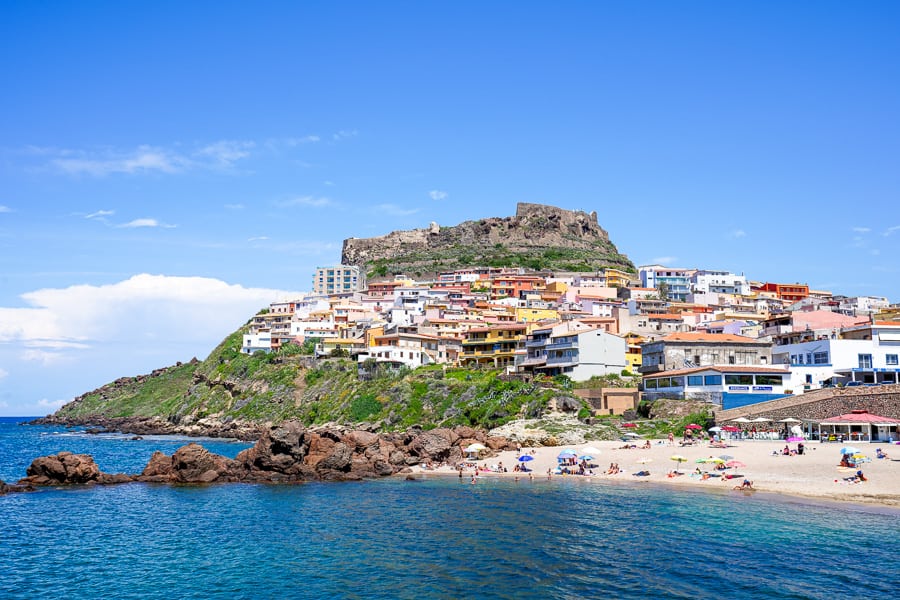
Capo Testa
It’s only an hour more to Palau. We made the best of our time today, and after checking in and dropping off our bags, headed out to explore Santa Teresa Gallura and Capo Testa.
Pretty Santa Teresa Gallura, around half an hour from Palau, is a great stop for some lunch, a wander and a swim at beautiful Spiaggia Rena Bianca before heading a few kilometres further to the rocky outcrop of Capo Testa.
Driving across the short spit of land to the headland, you are greeted by the imposing granite cliffs and crystal-clear turquoise waters of Capo Testa, a picture-postcard setting if ever there was one.
Try to park towards the end of Via Cala Spinosa as this is where many of the walking trails start from. Avoid the temptation to park at the circular turnaround at the very end of the road though, we saw the police giving out parking fines here.
We spent a couple of hours hiking the coastal paths here and marvelling at the unique rock formations, giant granite boulders and impossibly turquoise ocean that the area is famed for. Be sure to also climb up to the lighthouse for even more jaw dropping views.
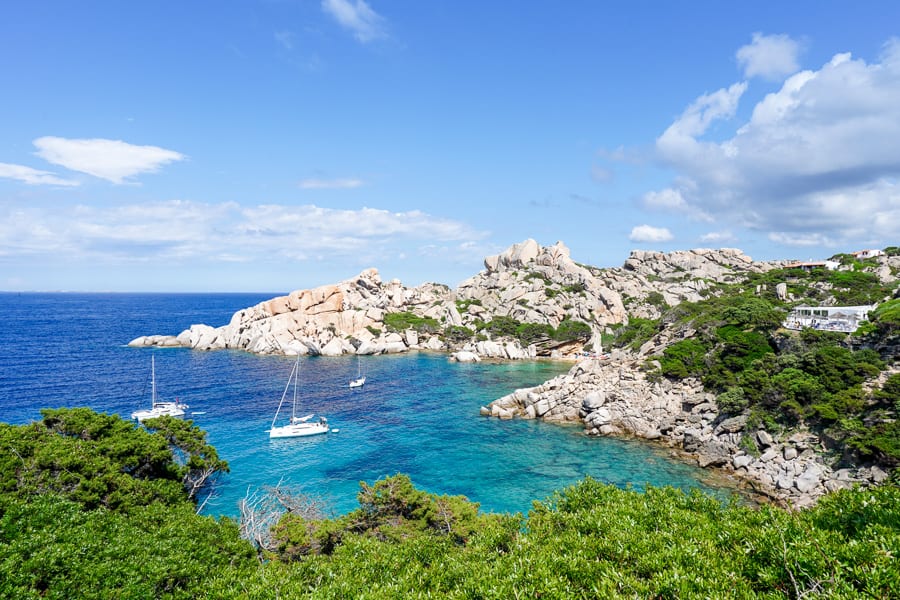
Our last stop today is La Fortezza di Monte Altura, only half an hour from Capo Testa on the way back to Palau. This imposing late-1800s fortress sits high on the slopes of Monte Altura, keeping watch over the rocky shoreline and blue expanse that lies between Sardinia and Corsica. The informative bilingual guided visit can be booked at the office adjacent to the car park at the bottom of the hill.
Where to Stay in Palau
As one of the major resort towns in the north of Sardinia and the gateway to the La Maddalena archipelago, Palau has a decent range of accommodation. Whether you are looking for a small boutique hotel, a cosy B&B, a full-service resort, or a private villa with poolside views over the ocean, Palau has you covered. The following options, all with parking, get consistently good reviews:
- Good value: AHR Costa Serena Village– clean self-catering apartment | resort facilities | waterfront café/restaurant
- Mid-range: La Vecchia Fonte Boutique Hotel – close to town and beaches | spacious rooms | friendly staff | paid parking
- Indulge: La Coluccia – stylish modern rooms | pool and sun terrace | fabulous views | close to beach | onsite restaurant
We opted for AHR Costa Serena Village as it was only a short drive from Palau, has free on-site parking and self-catering facilities, while also providing the usual resort style services like a pool, bar, shop and restaurants.
Day 8 – La Maddalena Archipelago by Boat
Highlights: La Maddalena Boat Tour
Overnight: Palau
Nestled off the island’s north-east tip overlooking Corsica, our visit to La Maddalena was one of the highlights of our Sardinia itinerary. The national park here is renowned for its crystal-clear turquoise waters, granite cliffs, diverse marine life, stunning beaches and fascinating history.
With more time, you could stay on some of the islands and explore at your leisure. For this itinerary we decided to explore the archipelago on a small boat day-trip from Palau with Sardinia Island Tours.
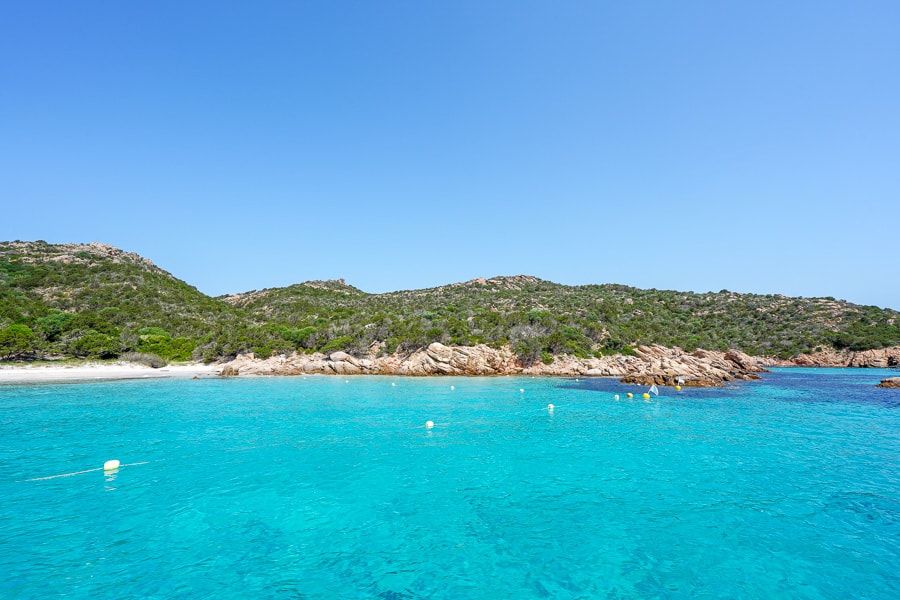
Heading north-west from the marina at Palau, our boat skirted the picturesque Sardinian coastline while our excellent skipper and guide Kevin talked us through some of the history of the area, pointing out significant landmarks and the occasional abode of the rich and famous.
We spent the next few hours on a leisurely navigation of the archipelago, exploring some of the most beautiful beaches in Sardinia, and the secluded coves of Spargi, Razzoli, Santa Maria and Santo Stefano islands. We also paused briefly offshore to admire the pretty strip of faintly pink-hued sand at Budelli Island, which is fully protected and off-limits to visitors.
We swam and snorkelled in the calm, crystal-clear ocean, relaxed in the sun, drank beer, marvelled at the wind-swept rock formations, and learnt about the archipelago’s military history while cruising past the many fortifications scattered across the islands.
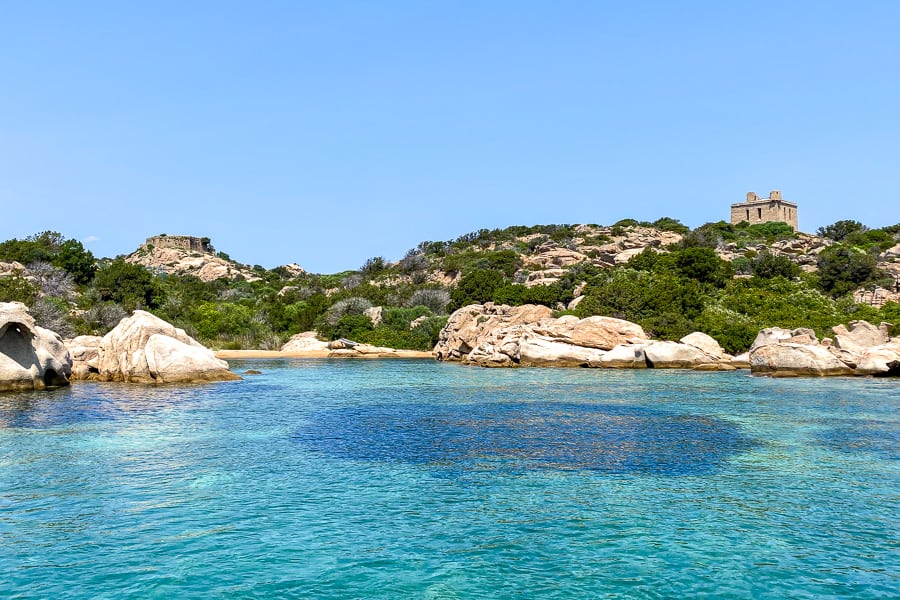
Day 9 – Costa Smeralda Beaches
Highlights: Spiaggia Capriccioli | Spiaggia del Principe
Total driving distance: appx. 80km (50 miles)
Total driving time: appx. 1 hour 45 min
Overnight: Palau
No Sardinia visit would be complete without at least one beach day, and the beaches of the famed Costa Smeralda are among the very best beaches in Sardinia, if not Italy. The only challenge you’ll have really, is choosing which stretch of sand to lay your towel on.
Spiaggia del Grande Pevero, Romazzino, Liscia Ruja, Cala di Volpe, Cala Granu are all great spots to drop a towel and grab a swim, but our particular favourites were Capriccioli and Spiaggia del Principe.
Spiaggia Capriccioli
For a perfect beach day, we’d recommend heading to the carpark at Capriccioli (€1.50 per hour or €18 for the day) and then take your pick from one of the four beautiful beaches that skirt the coastline here.
While all the Costa Smeralda beaches are fabulous, Capriccioli (nord), with its calm waters lapping a beautiful crescent-shaped bay of golden sand, surrounded by granite rocks and lush vegetation, was very much our favourite.
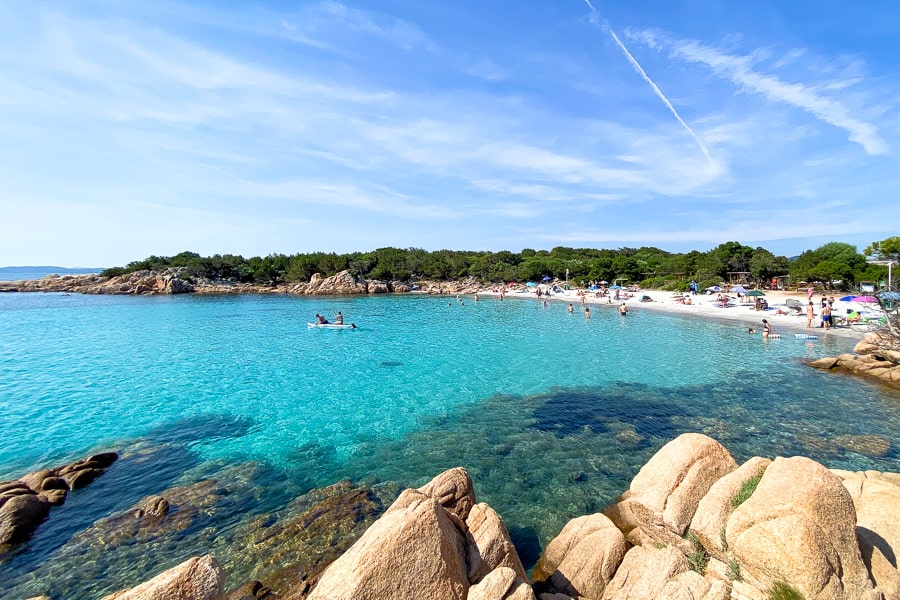
After a morning of beach time we headed up to Porto Cervo for a spot of lunch and a break from the scorching sun. A magnet for the (very) rich and famous, unless you’re in the market for some designer gear, you may, like us, need to settle for a pub lunch at the Lord Nelson. From here you can daydream about what life might be like on one of the superyachts parked in the marina in front of you.
Spiaggia del Principe
If lunch has revived you enough for more beach time, we’d recommend driving back down to Spiaggia del Principe. There’s a large, unpaved car park here (€2.50 per hour with a minimum of 2 hours).
Access to the beach is via a 5-minute walk down a fairly rough, sandy pathway. You get glimpses of what awaits as you walk, finally arriving at a fine curved stretch of sand abutted at each end by large boulders.
The water is calm and shallow here so it’s a great spot for swimming. The only real downside, like all the beaches in the area, is that it can get very busy.
Once you’ve had enough sun, head back to Palau for a lazy evening, perhaps a sundowner, and some dinner.
Day 10 – Palau to Cala Gonone via Olbia
Highlights: Olbia Centro Storico | Olbia Museo Archeologico | Spiaggia di Punta La Greca
Total driving distance: appx. 165km (100 miles)
Total driving time: appx. 1 hour 45 mins
Overnight: Cala Gonone
Day 10 of our Sardinia road trip takes us to our favourite town, beautiful Cala Gonone. But not before we check out the often overlooked port town of Olbia, and its beautiful southern coastline.
It’s only a short, 45-minute drive down to Olbia from Palau so you’ll have plenty of time for a stroll through the ambient cobbled streets of the Centro Storico, and to grab a coffee or bite to eat at one of the many cafes or restaurants here.
Finish your wander at the waterfront area, and head into the modern-looking Museo Archeologico di Olbia. While it feels a little like a work in progress, the museum hosts a diverse and interesting range of exhibits from the Nuragic, Phoenician and Roman eras that can be easily explored with the free audio guide.
If you’re history buffs like us, you’ll find the museum worth visiting just to see the impressive wrecks of wooden Roman cargo ships that were found during excavations of the port area.
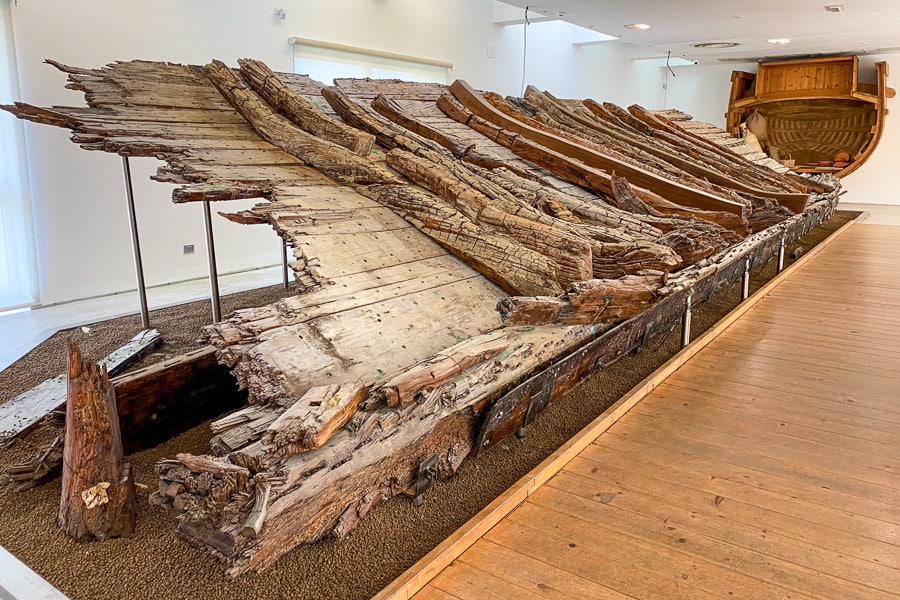
It takes a couple of hours to drive from Olbia to Cala Gonone, but instead of going the most direct route, consider taking the coastal SS125 south of Olbia to check out some of the beautiful coastline.
There are stacks of beaches and coves to explore along the coast here, although it’s worth bearing in mind that roads can be narrow in places, and parking isn’t always easy to find. We did manage to find a small, free carpark near Porto Cala Finanza, from which we were able to explore rocky Spiaggia di Punta La Greca and enjoy lovely views of Tavolara Island.
When you first exit the tunnel at the top of the mountain towards Cala Gonone, keep an eye out for a random mountaintop restaurant on the left. This is Pizzeria Chioco Monte Longu and it turned out to be another of our top spots in all of Sardinia – the views from the outside tables are stupendous. They serve some good Sardinian craft beers too. If you have any spare time over the coming days, swing by here at least once. It looks to be closed over winter.
You’ll find it hard to keep your eyes on the road during the final descent into Cala Gonone via winding switchbacks with dramatic views over the Gulf of Orosei. Time your drive today so you can check-in before taking a stroll into town to enjoy a sunset drink and dinner overlooking the water – we particularly liked the views, food and vibe at Snoopy restaurant.
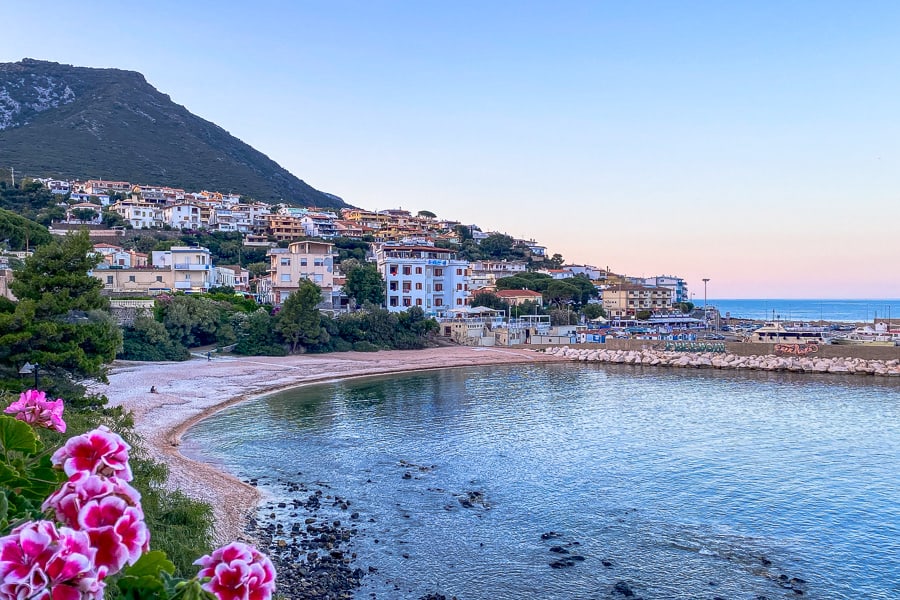
Cala Gonone Accommodation
Like all the other bases we’ve used on this Sardinia itinerary, Cala Gonone has a great variety of accommodation options to suit most tastes and budgets. The following options get consistently good reviews:
- Good value: Palmasera Bed & Breakfast– cosy rooms | 10 min walk to town | on-site parking (Paid)
- Mid-range: Hotel Ristorante La Conchiglia – large modern rooms | waterfront | free on-street parking or paid parking nearby
- Indulge: Hotel Caramare – central | close to beach | seaview rooms | free on-street parking or paid parking nearby
We stayed in a lovely, rustic two-bedroom apartment just five minutes up the hill from the waterfront, beach, restaurants and bars. The homely touches and added benefits of self-catering, along with a welcome view of the mountains and easy parking really did make La Bouganville feel like a home away from home.
Day 11 – Cala Gonone Hiking
Highlights: Gola Su Gorropu Hike
Total driving distance: appx. 36km (22 miles)
Total driving time: appx. 1 hour
Overnight: Cala Gonone
There are so many wonderful hikes around Cala Gonone it’s almost impossible to settle on just one.
The hike to Tiscali has some of the best mountain scenery we’ve encountered and ends at an incredibly evocative ruined Nuragic village in a vast, partially-collapsed cave. The Cala Luna and Cala Golritze hikes showcase some of Sardinia’s best coastal scenery. But if we had to settle on just one hike, we’d pick the hike to Gola Su Gorropu.
As it was quite wet on the day we hiked, we opted for the relatively easy, well-marked trail that starts at the S’Abba Arva Bridge. The trail follows the Rio Flumineddu through dense forest with wonderful glimpses of the spectacular Supramonte massif all around.
Allow 1.5 to 2 hours to walk the 6km (3.7 mile) trail, which winds slightly uphill to the mouth of the canyon. On arrival there’s a very small kiosk at the entry to the canyon where you pay a €5 entry fee, after which there’s a quick briefing before you’re free to explore.
There are three sections of the canyon to hike, separated by difficulty level. It’s worth noting that even the easy sections require a bit of scrambling over large boulders and rough ground. The reward for your efforts however, as you penetrate further into the ever-narrowing canyon with its sheer limestone walls, is nothing short of epic.
We spent a little over an hour in the canyon, enjoying a well-earned packed lunch before making the slightly easier hike back to S’Abba Arva Bridge.
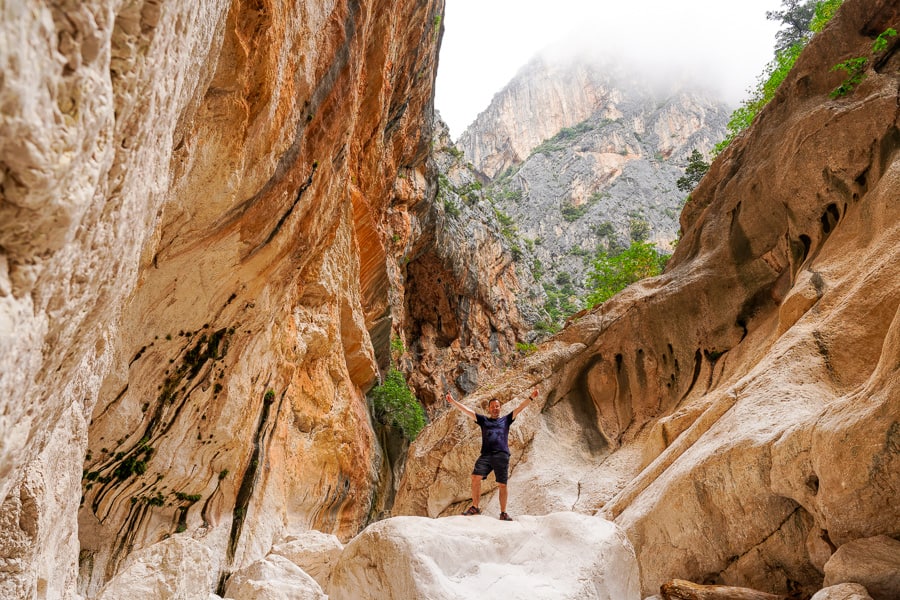
Alternative Route to Gola Su Gorropu
If you have decent weather, an alternative – and we’ve read more dramatic – route to Gola Su Gorropu, can be found opposite Hotel Silana (also called Hotel Gorropu) on SS125 at the Passo Ghenna Silana.
The route from here is around 8km (5 miles) and 2 hours each way and is said to provide incredible views over the canyon and surrounding area. The catch though, is that the steep route can be more challenging. Luckily, for those that can’t face the hike back up to Hotel Silana, we understand that jeep/minivan transfers can be booked as you go into the gorge.
Day 12 – Gulf of Orosei Boat & Beaches Tour
Highlights: Gulf of Orosei | Cala Golritze
Overnight: Cala Gonone
Today you’ll be experiencing one of the best things to do in Sardinia, a boat trip along the mesmerising Gulf of Orosei, which draws visitors in droves to the wild and rugged east coast of the island.
Backed by the imposing Supramonte, it’s hard not to be awed by the raw beauty of this place, with its high cliffs, turquoise waters, hidden coves, sea caves and pristine beaches.
There is no shortage of boat operators in Cala Gonone offering trips along the Gulf of Orosei. These range from large, crowded motor cruisers to luxury sailing boats, and shared or private rigid inflatable boats (RIBs).
While itineraries will vary, you can expect to cruise the coastline, get up close and personal with a few sea caves, and stop at some of the very best beaches in Sardinia, most likely Cala Luna, Cala Sisine, Cala Mariolu, Cala Biriola, Cala Gabbiani and Cala Goloritzé. Many trips also offer an excursion to Grotte del Bue Marino.
For us though, the highlights of the day were Cala Luna and Cala Goloritzé.
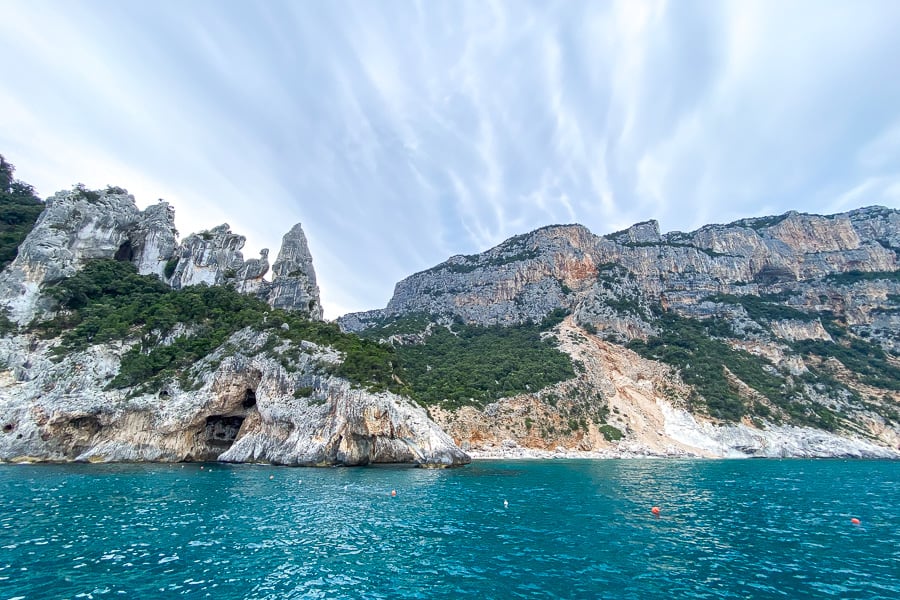
Cala Luna, with its gently curving shoreline dotted with limestone cliffs and large caves, is the poster child for the Gulf of Orosei, and you’ll see its iconic image on many a tour brochure.
And while you can’t land on the beach, you can expect to see the distinctive limestone pinnacle of Aguglia when you pass beautiful Cala Goloritzé, or if you’re in luck, moor off-shore for a dip.
Both of these beaches can also be reached by trail, so if you have more time, and plenty of energy, we would definitely recommend these hikes.
Gulf of Orosei Boat Trips: Cheap and Cheerful v Private
We opted for a cheap and cheerful all-day boat trip which took in all of the highlights and provided some basic complimentary snacks and a glass of vino on the way back to port.
This is a great option if you’re on a budget, however bear in mind these trips can get very crowded and can be slightly chaotic at times in their organisation and communication on the day.
Next time we may well hire a boat and explore at our own pace without the cast of thousands.
Day 13 – Around Cala Gonone
Highlights: Giant’s Tomb of S’Ena e Thomes | Su Gologone Spring | Valley of Oddoene Wine Tasting | Grotta di Ispinigoli | Nuraghe Mannu
Total driving distance: appx. 95km (59 miles)
Total driving time: appx. 2 hours
Overnight: Cala Gonone
As today is the last day in Cala Gonone, it’s time to get out and about and explore some of the best things to see in the area. We’re talking caves, Nuragic sites, natural springs and spectacular Sardinian vino, so strap yourself in for a busy day.
Nuraghe Mannu
You’ll find Nuraghe Mannu a few minutes’ drive from Cala Gonone, set high on the volcanic rock slope overlooking Cala Gonone and the Gulf of Orosei.
Originally built around 1600BC, today you’ll find a largely ruined site with basalt blocks strewn across a landscape dominated by a crumbling tower, and the remnants of both Nuragic and Roman structures. While the nuraghe is undoubtedly interesting if you like your history, the real highlight is the sweeping views along the coastline.
Entry to the site is around 800 metres down a rough path from the small parking area. As we have a busy day today, plan to be here for opening, which is normally 9am.
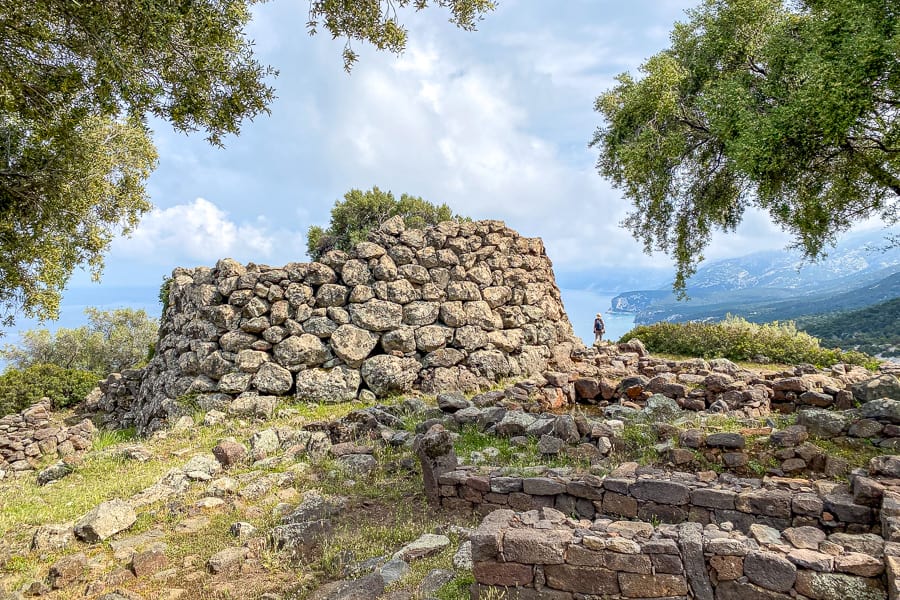
Grotta di Ispinigoli
The second tallest stalagmite in the world awaits at Grotta di Ispinigoli, around 30 minutes’ drive from Nuraghe Mannu. Try to get here in time for the 11am guided tour of this beautiful cave system, but on the way, keep your eyes peeled for more fabulous coastal and mountain views.
Giant’s Tomb of S’Ena e Thomes
Next, take a 20-minute drive along picturesque SP38 until you get to the small gravel parking lot for the Giant’s Tomb of S’Ena e Thomes. There are hundreds of these distinctive dolmens, with their curved slabs and large central stele, scattered across Sardinia.
The S’Ena e Thomes grave is an impressive, well-restored example dating back almost 4,000 years. The site is free to enter, just pass through the gate by the car park and walk 5 minutes through the slightly overgrown scrub to the tomb. Keep an eye out for arrows made of rocks that point the way.
Su Gologone Spring
It’s a beautiful 20-minute drive surrounded by lush forest, rivers and the high peaks of the Supramonte to reach Su Gologone Spring. This is the point where water from the Supramonte’s underground river system rushes through a limestone fissure into a stunning emerald pool before joining the Cedrino River.
It’s a nice spot to relax for a while and take a break from a busy day. Either bring a snack and have a picnic in the shade, or stop for a coffee or something to eat at the nearby restaurant.
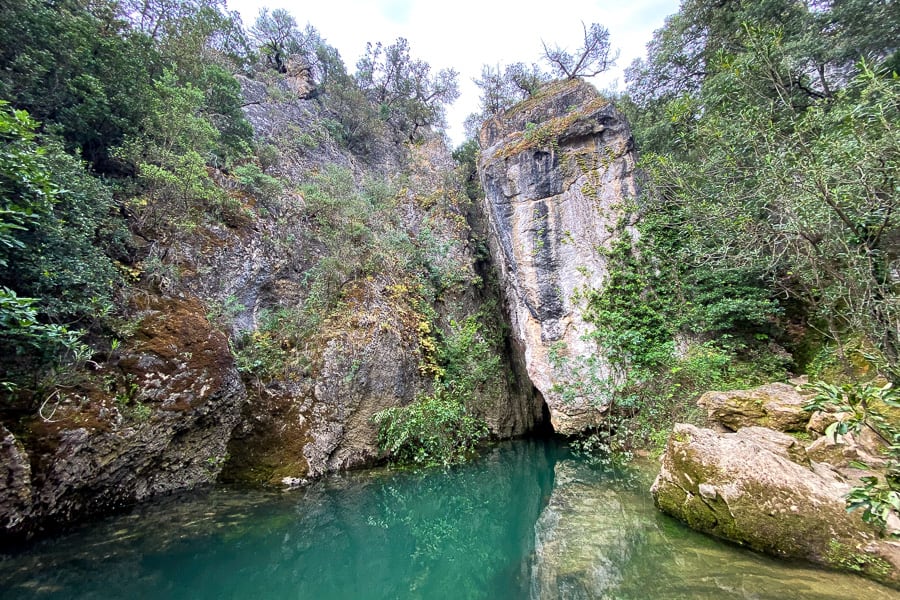
Visit a Winery in the Beautiful Valley of Oddoene
Less than half an hour from Su Gologone Spring, you’ll find yourself in the Valley of Oddoene, encircled by the Supramonte mountains and surrounded by lush vegetation, olive groves, and small, family-owned vineyards.
What better way to end a gruelling day of sightseeing than with a guided tasting of incredible local Cannonau accompanied by local cheese, cured meat, bread and views to die for? The only downside is someone needs to be the designated driver – so be sure to take some wine with you for later, fair’s fair.
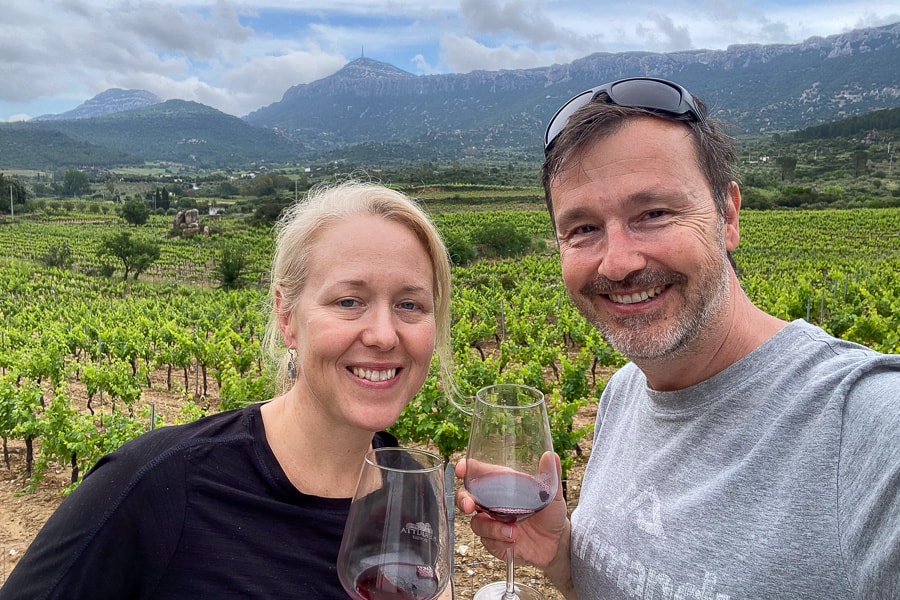
Day 14 – Cala Gonone to Cagliari via the Supramonte
Highlights: Driving the Spectacular SS125 | Red Rocks Beach near Arbatax
Total driving distance: appx. 280km (125 miles)
Total driving time: appx. 4.5 hours
Overnight: Cagliari (or fly home)
We’ve planned some sightseeing for the last full day of this two-week Sardinia road trip, with an overnight stay in Cagliari before flying out tomorrow. However, if you’re flying out today and need to hightail it to Cagliari’s international airport, it’s a 3-hour, 200km (125 mile) drive from Cala Gonone.
Regardless of which of these options you take, you’ll get to drive the most spectacular road in Sardinia – the 60km (37 mile) stretch of the SS125 between Dorgali and Santa Maria Navarrese. You’ll need all of your concentration for this as the mountains, gorges and valleys of the Supramonte are a constant distraction.
If you aren’t flying out today, stay on the SS125 past Santa Maria Navarrese, following the road all the way to Arbatax, about 1.5 hours’ drive from Cala Gonone.
While it’s not necessarily a place you’d make a special trip for, Arbatax is a good spot to break the journey to Cagliari. The main attraction here is the famous Red Rocks Beach, with its cathedralesque red porphyry rocks backed by a (sometimes) turquoise bay.
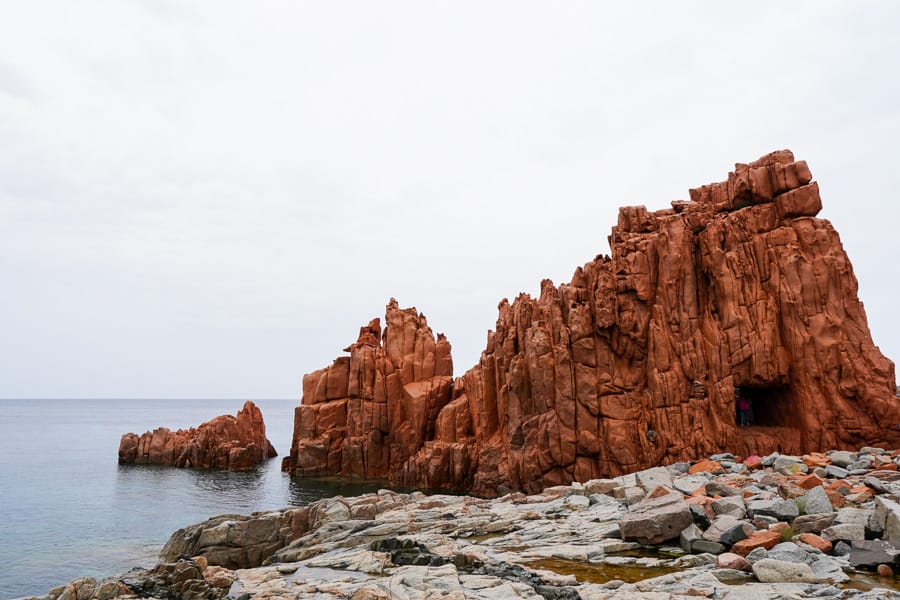
The views from nearby San Gemiliano Tower are also worth seeing while you are here, and if you’ve worked up an appetite, there’s plenty of fresh seafood on offer in the local area.
Finish the day with the final 207km stretch to Cagliari, before checking into your hotel, and heading into town for one final amazing Sardinian meal.
Homeward Bound
Depending on what time you fly, you can choose your own adventure today. This might be just grabbing one last delicious Italian coffee, or wandering Il Castello’s ambient streets and seeing an attraction you couldn’t quite fit in last time you were here.
With a bit more time, it’s possible to head out to Cagliari’s peaceful Botanical Garden, or take a stroll up to nearby Monte Urpinu Park for a bit of greenery and panoramic views of the city.
On our last day, we inevitably found ourselves reminiscing about an incredible road trip over a glass of Cannanou, and wishing we had some extra time up our sleeves to see more of this stunning island.
Feels like another trip might well be required.
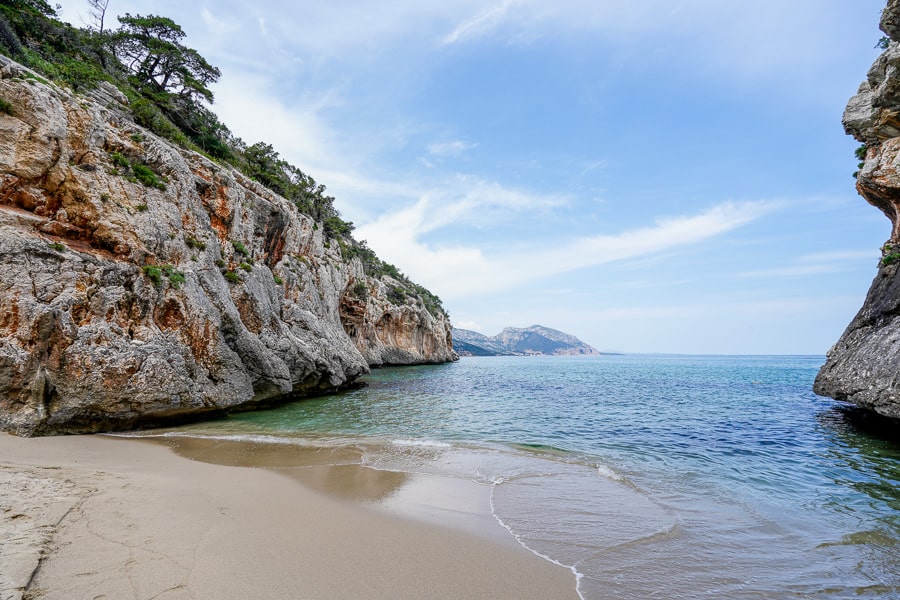
Sound like your kind of action-packed trip? If you’ve got any questions about our two week Sardinia road trip itinerary, please ask us in the comments below.
If you’re looking for more great road tripping itineraries and adventures, check out our Road Trips page, and our bucket list of 100 ultimate road trips around the world
